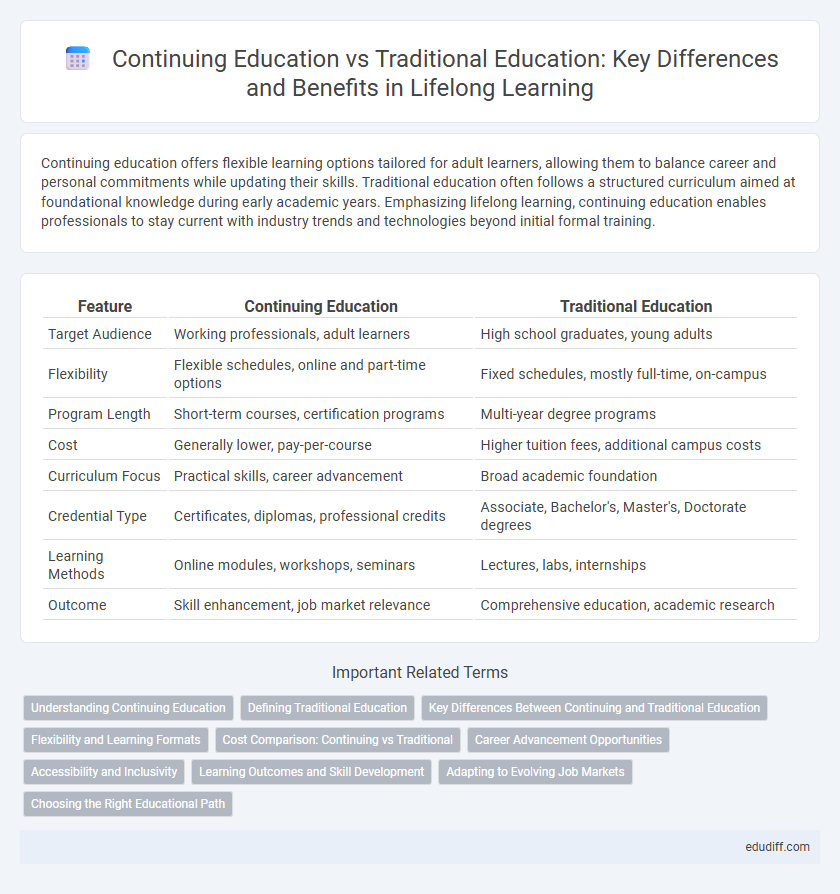Continuing education offers flexible learning options tailored for adult learners, allowing them to balance career and personal commitments while updating their skills. Traditional education often follows a structured curriculum aimed at foundational knowledge during early academic years. Emphasizing lifelong learning, continuing education enables professionals to stay current with industry trends and technologies beyond initial formal training.
Table of Comparison
| Feature | Continuing Education | Traditional Education |
|---|---|---|
| Target Audience | Working professionals, adult learners | High school graduates, young adults |
| Flexibility | Flexible schedules, online and part-time options | Fixed schedules, mostly full-time, on-campus |
| Program Length | Short-term courses, certification programs | Multi-year degree programs |
| Cost | Generally lower, pay-per-course | Higher tuition fees, additional campus costs |
| Curriculum Focus | Practical skills, career advancement | Broad academic foundation |
| Credential Type | Certificates, diplomas, professional credits | Associate, Bachelor's, Master's, Doctorate degrees |
| Learning Methods | Online modules, workshops, seminars | Lectures, labs, internships |
| Outcome | Skill enhancement, job market relevance | Comprehensive education, academic research |
Understanding Continuing Education
Continuing education offers flexible learning opportunities tailored to adult learners seeking skill enhancement or career advancement beyond traditional degree programs. It encompasses diverse formats such as online courses, workshops, and professional certifications that integrate practical knowledge with evolving industry demands. Emphasizing lifelong learning, continuing education supports ongoing personal and professional development in dynamic job markets.
Defining Traditional Education
Traditional education typically involves structured, classroom-based learning led by certified teachers within accredited institutions, offering standardized curricula designed to cover foundational knowledge across subjects. It emphasizes fixed schedules, formal assessments, and credentialing systems, such as diplomas or degrees, to measure student progress and achievement. This approach prioritizes systematic instruction and aligns with established educational standards and regulations at regional or national levels.
Key Differences Between Continuing and Traditional Education
Continuing education differs from traditional education by offering flexible scheduling tailored for working adults, enabling learners to balance education with professional and personal commitments. Unlike traditional programs that follow a fixed curriculum over several years, continuing education provides short-term, skill-specific courses that respond to current industry demands. Assessment in continuing education is often practical and competency-based, emphasizing immediate application of knowledge rather than theoretical exams common in traditional settings.
Flexibility and Learning Formats
Continuing Education offers unparalleled flexibility with self-paced online courses, evening classes, and hybrid formats designed for working adults. Traditional Education typically follows fixed schedules with in-person lectures and limited options for remote learning. The diverse learning formats in Continuing Education cater to varied lifestyles, enabling learners to balance education with personal and professional commitments effectively.
Cost Comparison: Continuing vs Traditional
Continuing education often offers more affordable options compared to traditional education, with flexible payment plans and lower overall tuition fees. Traditional education usually involves higher costs due to campus facilities, housing, and full-time enrollment fees. Many continuing education programs provide cost-effective alternatives without compromising the quality of learning.
Career Advancement Opportunities
Continuing education provides targeted skill development and practical knowledge that align with evolving industry demands, significantly enhancing career advancement opportunities. Traditional education offers a foundational understanding but may lack the flexibility and specificity needed for rapid professional growth in dynamic job markets. Employers increasingly value continuing education credentials for their relevance and immediate applicability to career progression.
Accessibility and Inclusivity
Continuing education offers enhanced accessibility through flexible scheduling, online platforms, and affordable options, making learning opportunities available to a broader audience, including working adults and underserved communities. Traditional education often requires fixed attendance and higher costs, which can limit access for non-traditional students or those with disabilities. Inclusive curricula and adaptive technologies in continuing education further drive equity by accommodating diverse learning needs and promoting lifelong skill development.
Learning Outcomes and Skill Development
Continuing education emphasizes practical skill development and up-to-date knowledge tailored to industry demands, resulting in immediate applicability and enhanced job performance. Traditional education offers a comprehensive theoretical foundation, fostering critical thinking and broad intellectual growth over an extended period. Both approaches contribute uniquely to learning outcomes, with continuing education driving specialized expertise and traditional education promoting foundational understanding.
Adapting to Evolving Job Markets
Continuing education emphasizes skill development tailored to emerging industries and dynamic job requirements, enabling professionals to stay relevant and competitive. Traditional education often follows fixed curricula that may not align with rapid technological advancements or shifting market demands. Adaptive learning models in continuing education prioritize practical application, fostering lifelong learning that directly responds to evolving employment landscapes.
Choosing the Right Educational Path
Choosing the right educational path depends on individual goals, learning styles, and career aspirations. Continuing education offers flexible schedules and targeted skill development for working professionals, while traditional education provides a structured environment and comprehensive foundational knowledge. Evaluating factors such as time commitment, learning format, and long-term objectives ensures an informed decision between continuing education and traditional degree programs.
Continuing Education vs Traditional Education Infographic

 edudiff.com
edudiff.com